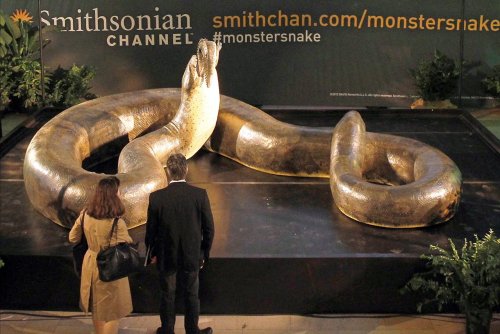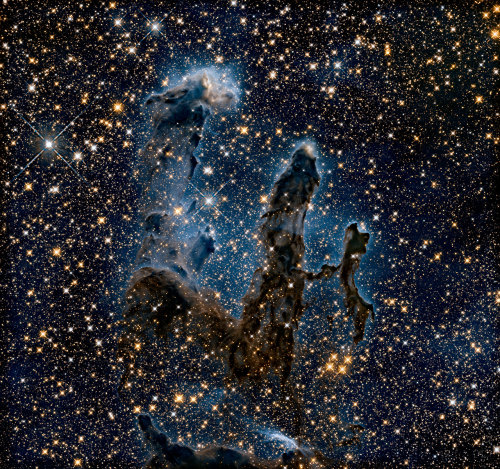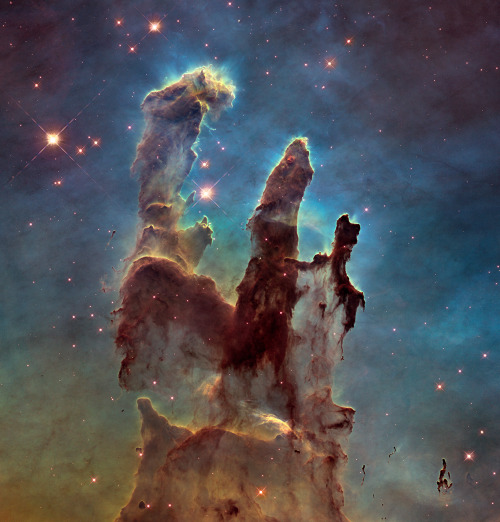Sometimes I Think About The Golden Record And I Want To Cry
sometimes i think about the golden record and i want to cry
More Posts from Starry-shores and Others
neohumanity
Grand Prismatic Spring: The most beautiful and dangerous hot spring in the world. Filmed from a helicopter 🚁 Shot on
@lexarmemory
.


The Titanoboa, is a 48ft long snake dating from around 60-58million years ago. It had a rib cage 2ft wide, allowing it to eat whole crocodiles, and surrounding the ribcage were muscles so powerful that it could crush a rhino. Titanoboa was so big it couldn’t even spend long amounts of time on land, because the force of gravity acting on it would cause it to suffocate under its own weight.


Sometimes… there’s more than meets the eye. 👀 You’re looking at two very different takes on an iconic image.
Human eyes can see only a small portion of the range of radiation given off by the objects around us. We call this wide array of radiation the electromagnetic spectrum, and the part we can see visible light.
In the first image, researchers revisited one of Hubble Space Telescope’s most popular sights: the Eagle Nebula’s Pillars of Creation. Here, the pillars are seen in infrared light, which pierces through obscuring dust and gas and unveil a more unfamiliar — but just as amazing — view of the pillars. The entire frame is peppered with bright stars and baby stars are revealed being formed within the pillars themselves. The image on the bottom is the pillars in visible light.
Image Credit: NASA, ESA/Hubble and the Hubble Heritage Team
Make sure to follow us on Tumblr for your regular dose of space: http://nasa.tumblr.com.
Helicoprion: What if, like, teeth,
Mesosaurus: Yeah?
Helicoprion: but WHEEL
Mesosaurus: No don't -
Helicoprion:

(Image by ДиБгд)

Stars and Dust in Corona Australis : Cosmic dust clouds and young, energetic stars inhabit this telescopic vista, less than 500 light-years away toward the northern boundary of Corona Australis, the Southern Crown. The dust clouds effectively block light from more distant background stars in the Milky Way. But the striking complex of reflection nebulae cataloged as NGC 6726, 6727, and IC 4812 produce a characteristic blue color as light from the region’s young hot stars is reflected by the cosmic dust. The dust also obscures from view stars still in the process of formation. At the left, smaller yellowish nebula NGC 6729 bends around young variable star R Coronae Australis. Just below it, glowing arcs and loops shocked by outflows from embedded newborn stars are identified as Herbig-Haro objects. On the sky this field of view spans about 1 degree. That corresponds to almost 9 light-years at the estimated distance of the nearby star forming region. via NASA
RECORD BREAKERS
Life on earth, as magnificent and versatile as it is, is seemingly tame compared to the weird and wonderful creatures that once existed. All categories of life have reached unimaginable sizes, here are just a selection of prehistoric record breakers!

MEGALODON The biggest shark known to have existed, ruling over the oceans as recently as up to a million years ago. A length of almost 20 metres and weighing in at an estimated 48 tonnes, Megalodon could deliver a crucifying bite of up to 110,000N. It is no surprise that the Megalodon was dubbed the “whale killing shark”.
MEGATHERIUM Our early ancestors would have been quite familiar with Megatherium as they existed up to 8000 years ago, they were in fact the largest sloths to have existed. Sloths have a reputation as being lazy, slow and docile, but Megatherium was a 6 metre long, 4 tonne monster with a killer instinct and knife-like claws. Megatherium’s discovery came before that of the dinosaurs. Skeletons of these prehistoric beasts were a delight to the Victorian public and paved the way for the science of palaeontology.

ARCHELON Literally meaning “large turtle”, Archelon certainly was just that. Existing during the cretaceous, the time of the dinosaurs, Archelon could reach 4.5 metres long and may have lived to over 100 years old. Archelon could not compete with other cretaceous beings in speed and agility, but its blade-like beak was able to slice through flesh and crush though the toughest ammonite shells. Unfortunately Archelon appears to have been a popular snack for other marine dwellers, skeletons are frequently missing flippers or heads and covered in slashes.
TITANOBOA When the dinosaurs reign ended, a new era saw the rise of new super-predators, one was Titanoboa, the largest snake ever with a body up to 13 metres long, standing a metre off the ground and weighing up to 2500 pounds. Titanoboa was 30% longer than even todays largest species. Scientists believe this humongous snake hunted like its modern relatives, the boa constrictors, by winding around prey and suffocating them.

IRISH ELK Owner of the largest antlers of any animal, up to 3 metres wide, the Irish Elk gets its name from its frequent discoveries in Irish peat bogs. Existing up to 10,000 years ago, these would have been a common sight in grasslands for our ancestors. Many fossils indicate the animals died of starvation which is why the antlers are thought to have been part of elaborate mating contests between males, often resulting in one being fatally injured and unable to feed itself.
DEINOTHERIUM A distant relative of the elephants and mammoths, Deinotherium was more sinister, its name translates to “terrible beast”, they would have most likely caused trouble for our ancient ancestors around 1.5 million years ago. Deinotherium is actually considered to be the second largest land mammal of all time, behind Paraceratherium and is iconic in appearance due to its sharp, downward facing tusks.
ARCTODUS Known as the short faced bear, they were the biggest bears on record and one of the largest mammal carnivores to have existed. Whilst their skull was short, they were packed with piercing teeth that could deliver a bone crushing bite. Existing up to 11,000 years ago, out ancestors would have stayed well clear of this 900 kilogram predator, with slender limbs and knife-like claws, Arctodus was deadly.

SARCOSUCHUS One of the most infamous fossil discoveries in history, Sarcosuchus was the largest crocodile to walk the Earth up to 112 million years ago, this was a crocodile capable of killing dinosaurs. Sarcosuchus was twice as long as a saltwater crocodile, that’s 11-12 metres long and could reach over 8 tonnes. Its jaw was packed full of 66 teeth either side of its jaw and would have clamped down on prey that wandered too near.
ARGENTINOSAURUS One of the largest lifeforms that has ever stood on the Earth, Argentinosaurus could grow up to 30 metres long with its hind limbs standing 4.5 metres off the ground. They existed between 97-94 million years ago and at adulthood would have been virtually indestructible to predators. Its weight is estimated at a staggering 80-100 tonnes. There hasn’t been another land mammal on the same scale as Argentinosaurus since and it’s unlikely there ever will be.

SPINOSAURUS The largest discovered therapod ever, a group that includes Allosaurus and Tryrannosaurus. Spinosaurus remained an enigma to scientists for decades, the only discovered specimen was sadly destroyed during World War 2 and was not rediscovered until the 21st century. Spinosaurus is thought to have reached up to 16 metres long and weighed in around 12 tonnes, that is almost double the weight of a T-rex!
-
 mega-swablu liked this · 1 week ago
mega-swablu liked this · 1 week ago -
 thetwinarmageddons reblogged this · 1 week ago
thetwinarmageddons reblogged this · 1 week ago -
 gay4mormonz liked this · 1 week ago
gay4mormonz liked this · 1 week ago -
 quipofthetongue reblogged this · 1 week ago
quipofthetongue reblogged this · 1 week ago -
 isitmemesyourelookingfor liked this · 1 week ago
isitmemesyourelookingfor liked this · 1 week ago -
 ashwolf011 liked this · 1 week ago
ashwolf011 liked this · 1 week ago -
 aro-ace-fangirl reblogged this · 1 week ago
aro-ace-fangirl reblogged this · 1 week ago -
 tesdradgon reblogged this · 1 week ago
tesdradgon reblogged this · 1 week ago -
 shadow-pixelle reblogged this · 1 week ago
shadow-pixelle reblogged this · 1 week ago -
 blog-6 liked this · 2 weeks ago
blog-6 liked this · 2 weeks ago -
 bellawhelka reblogged this · 2 weeks ago
bellawhelka reblogged this · 2 weeks ago -
 bellawhelka liked this · 2 weeks ago
bellawhelka liked this · 2 weeks ago -
 bugandbreakfast reblogged this · 2 weeks ago
bugandbreakfast reblogged this · 2 weeks ago -
 wyvernbutch reblogged this · 2 weeks ago
wyvernbutch reblogged this · 2 weeks ago -
 hou-yi liked this · 2 weeks ago
hou-yi liked this · 2 weeks ago -
 vileiguana liked this · 2 weeks ago
vileiguana liked this · 2 weeks ago -
 girltwinkcn reblogged this · 2 weeks ago
girltwinkcn reblogged this · 2 weeks ago -
 scp3199 reblogged this · 2 weeks ago
scp3199 reblogged this · 2 weeks ago -
 scp3199 liked this · 2 weeks ago
scp3199 liked this · 2 weeks ago -
 girltwinkcn reblogged this · 2 weeks ago
girltwinkcn reblogged this · 2 weeks ago -
 cosmiccoldbrew liked this · 2 weeks ago
cosmiccoldbrew liked this · 2 weeks ago -
 girltwinkcn liked this · 2 weeks ago
girltwinkcn liked this · 2 weeks ago -
 jadesaidshedneverchangeherurl liked this · 2 weeks ago
jadesaidshedneverchangeherurl liked this · 2 weeks ago -
 veiledpurple liked this · 2 weeks ago
veiledpurple liked this · 2 weeks ago -
 lostryu reblogged this · 2 weeks ago
lostryu reblogged this · 2 weeks ago -
 fuckingayassbitch reblogged this · 2 weeks ago
fuckingayassbitch reblogged this · 2 weeks ago -
 library-seraph reblogged this · 2 weeks ago
library-seraph reblogged this · 2 weeks ago -
 leche-flandom liked this · 2 weeks ago
leche-flandom liked this · 2 weeks ago -
 i-am-a-lonely-nerd reblogged this · 2 weeks ago
i-am-a-lonely-nerd reblogged this · 2 weeks ago -
 we-re-always-alright reblogged this · 2 weeks ago
we-re-always-alright reblogged this · 2 weeks ago -
 sushi1056 reblogged this · 2 weeks ago
sushi1056 reblogged this · 2 weeks ago -
 sushi1056 liked this · 2 weeks ago
sushi1056 liked this · 2 weeks ago -
 long-form-contentment reblogged this · 2 weeks ago
long-form-contentment reblogged this · 2 weeks ago -
 jennserr reblogged this · 3 weeks ago
jennserr reblogged this · 3 weeks ago -
 pleasantgothbasketballthing liked this · 3 weeks ago
pleasantgothbasketballthing liked this · 3 weeks ago -
 letskilltimetogether liked this · 3 weeks ago
letskilltimetogether liked this · 3 weeks ago -
 rogueofbullshit reblogged this · 3 weeks ago
rogueofbullshit reblogged this · 3 weeks ago -
 rogueofbullshit reblogged this · 3 weeks ago
rogueofbullshit reblogged this · 3 weeks ago -
 rogueofbullshit liked this · 3 weeks ago
rogueofbullshit liked this · 3 weeks ago -
 nonchalantxfish reblogged this · 3 weeks ago
nonchalantxfish reblogged this · 3 weeks ago -
 alwaysandforver17 liked this · 3 weeks ago
alwaysandforver17 liked this · 3 weeks ago -
 aisuryuu reblogged this · 3 weeks ago
aisuryuu reblogged this · 3 weeks ago -
 aisuryuu liked this · 3 weeks ago
aisuryuu liked this · 3 weeks ago -
 cronais liked this · 3 weeks ago
cronais liked this · 3 weeks ago -
 asterlizard liked this · 3 weeks ago
asterlizard liked this · 3 weeks ago -
 azuraseal liked this · 3 weeks ago
azuraseal liked this · 3 weeks ago -
 hollowsart liked this · 3 weeks ago
hollowsart liked this · 3 weeks ago -
 janaxiv reblogged this · 3 weeks ago
janaxiv reblogged this · 3 weeks ago -
 books-and-gardens reblogged this · 3 weeks ago
books-and-gardens reblogged this · 3 weeks ago

Amateur astronomer, owns a telescope. This is a side blog to satiate my science-y cravings! I haven't yet mustered the courage to put up my personal astro-stuff here. Main blog : @an-abyss-called-life
212 posts










